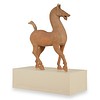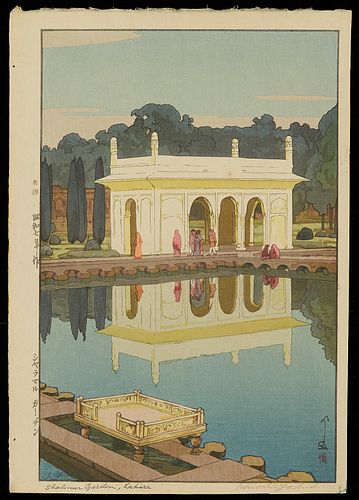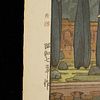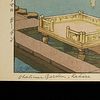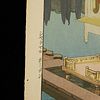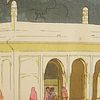Bid Increments
| Price | Bid Increment |
|---|---|
| $0 | $25 |
| $300 | $50 |
| $1,000 | $100 |
| $3,000 | $200 |
| $5,000 | $500 |
| $10,000 | $1,000 |
| $20,000 | $2,000 |
| $50,000 | $5,000 |
| $100,000 | $10,000 |
| $500,000 | $25,000 |
| $1,000,000 | $50,000 |
| $10,000,000 | $100,000 |
One of the leading figures in the Japanese Shin-hanga movement, Hiroshi Yoshida was born in Fukuoka in 1876. In 1893, he moved to Kyoto and studied yoga and nihonga styles of painting and watercolors. It came only in middle age he started collaborating with the shin-hanga publisher Watanabe Shozaburo. Despite his late debut as a shin-hanga printmaker, he successfully put himself on the map as the greatest artist of the shin-hanga style and is especially noted for his excellent landscape prints. His prints are highly recognized in both Japan and overseas.
Height: 15 3/4 in x width: 11 in.
Condition
Available payment options

Payment & Shipping PAYMENT Revere Auctions accepts wire transfers, checks (personal or business check in US dollars certified by a US bank, a cashier’s/banker’s check drawn on a US bank or US money order), cash (US currency not to exceed $10,000 in a single or multiple related payments). Visa, Discover, American Express or MasterCard may be used and are subject to a 3.0% convenience fee and are limited to purchases of $5,000.00 (total). Credit Card payments for jewelry and gold are NOT accepted. The purchaser’s obligation to pay immediately the full purchase price is absolute and unconditional and is not subject to any defenses, setoffs or counterclaims of any kind whatsoever. Revere Auctions is not obligated to release a lot to the purchaser until title to the lot has passed. The purchaser agrees to pay Revere Auctions handling charge of $30 for any check dishonored by the drawee. SHIPPING Revere Auctions does NOT offer in-house shipping. As a convenience to the Buyer, Revere Auctions will make a referral for packing and shipping. This is at the request, expense, and risk of the Buyer, and Revere Auctions assumes no responsibility for the items or the timing of delivery. Insurance for in transit items is the responsibility of the buyer. The buyer must reach out to a shipping company to arrange shipping. The buyer must fill out and return the Shipping Release Form to info@revereauctions.com in order for their items to be released. This is to ensure that the won item(s) are given to the proper shipping company and reach their final destination safely. This form can be found here: https://www.revereauctions.com/wp-content/uploads/2022/07/ShippingRelease_Fillable2022.pdf Here is a list of our preferred shippers: UPS Store #2105 Contact: Ryan Wilson Email: store2105@theupsstore.com Phone: 651-642-5972 UPS Store #2158 Contact: Randy Email: store2158@theupsstore.com phone: 651-635-0636 UPS Store #5396 Contact: Ivory Email: store5396@theupsstore.com Phone: 612-332-4117 Museum Services Inc For shipping estimate please complete the following link: http://museumservices.org/revere For our full list of shipping referrals and information please see our shipping information page with more details: https://www.revereauctions.com/shipping-information/
Inquire

Please enter your email to login
Enter email to create an account to start bidding.
Enter email to create an account to start bidding.
